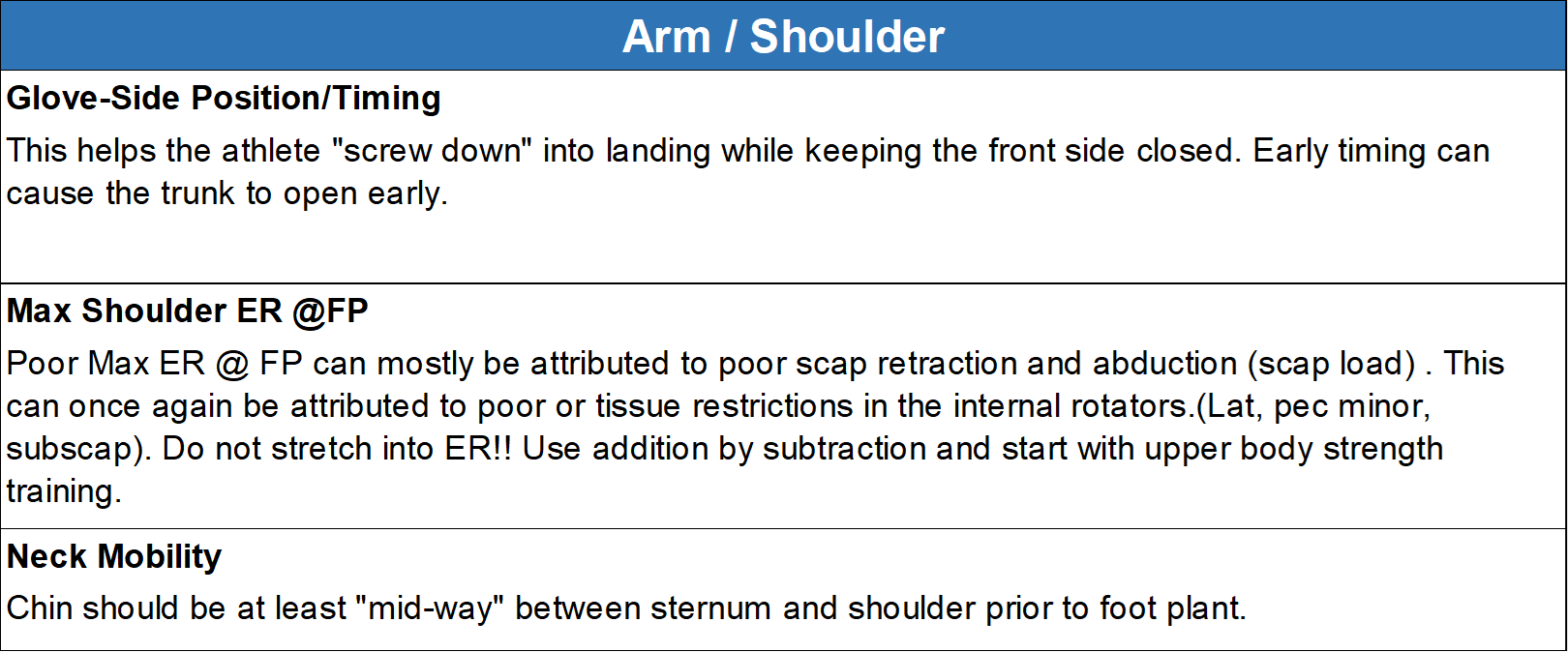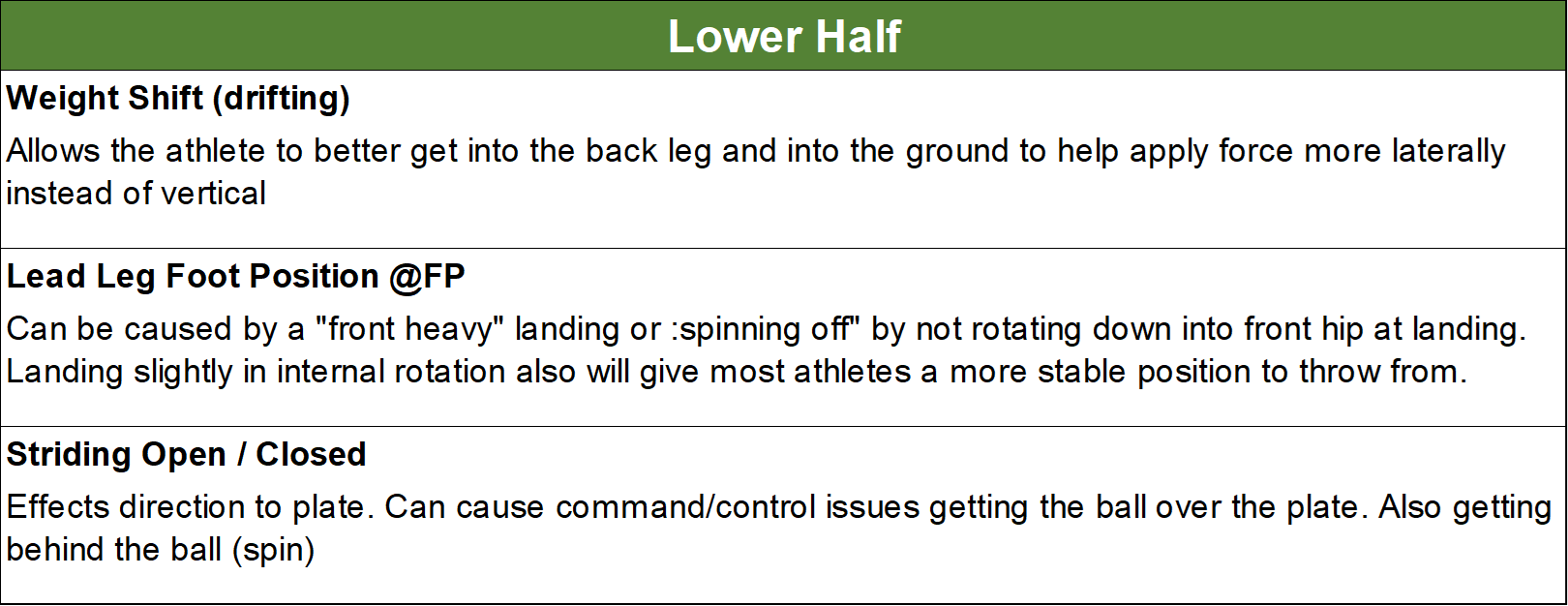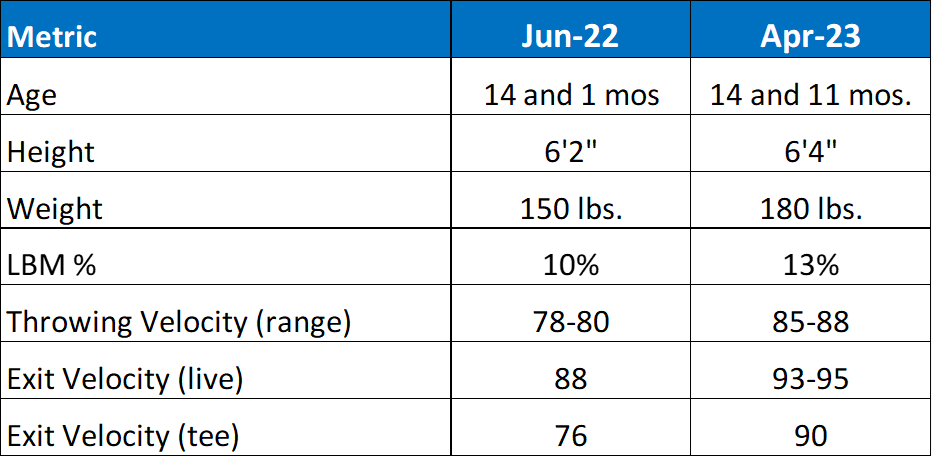
Graham Keen, 2-way player in the class of 2027, came to us in June of 2022 after a recommendation from Matt Pilewski, owner operator at PVS Baseball based in Pittsburgh, PA. Although Graham is a 2-way player, our initial assessment was focused on his physicality and pitching mechanics.
After 10 months of hard work he has made significant gains, with his pitching velocity up 7-8 mph to 85-88 mph. So, how did he do it?
The following is a summary of his initial metrics:
-
- Height – 6’2”
- Weight – 150 lbs.
- Pitching Velocity – 78-80 mph
- Exit Velocity – 88 (Live), 76 (Tee)
Back in June, when he had just turned 14 , he was 6’2” and 150 lbs. and was highly recommended to us by Matt Pilewski as an athlete with a very high ceiling. However, Graham’s mom Tricia informed us that he complained of anterior pain in the lead hip after pitching or hitting. In this article, we will be diving into the “blueprint” for Graham’s programming during these past 10 months, which included:
-
- Increasing Lean Body Mass
- Improving Mobility
- Improving Strength
- Addressing Mechanical Disconnects
I think it’s important to mention that even the best programs won’t work if you’re not consistent with your training. That being said, Graham took the bull by the horns, listened to all the advice, and remained consistent in his training during this period.
Let’s get into it…
The Game Plan
When Graham started training with us, he had limited training experience. As a result, we used a more concurrent model as opposed to the strict block periodization (reserved for older athletes with a higher training age). This allowed us to focus on strength, speed, and endurance, over the same period, with the intention of producing a more multi-faceted athlete. Historically, this has worked well for us when dealing with athletes of a younger training age. That being said, let’s take a closer look at what we did with him over the past 10 months.
Increasing Lean Body Mass
Graham’s baseline assessment when he started his remote training with us had him at 6’2” and 150 lbs. Knowing that lean body mass has one of the highest correlations to velocity and reduced injury risk, we knew that getting him to around 2.5-3.0x (height to weight ratio) was his lowest hanging fruit. So, putting on 25-30 lbs. of lean mass was first priority.
Improving Mobility
The movement screen highlighted several areas of potential improvement. The most important were:
-
- Glute activation (was firing hamstrings first)
- Ankle mobility (both dorsiflexion, and eversion)
- Insufficient t-spine rotation
- Insufficient hip ER mobility
On the mobility front, the big players (even more than limited ER in his hips), were not being able to fire his glutes, as well as an unstable lower half due to limited ankle mobility (and strength). This was contributing to a compromised decel pattern on his front leg and ultimately forcing the lead hip to take the brunt of the force at landing, both on the mound and behind the plate. So, his initial program focused on a higher volume of drills to focus on these issues.
Improving Strength
Graham’s second biggest opportunity on the journey is strength. This is to be expected given his age with limited prior lifting experience. Graham scored high on his plyometric testing, so we knew that he has been surviving on his great “elastic” ability.

While this is a great trait, getting him more strength and stability (stiffness), while maintaining what he already does well (elasticity) was key. So, we focused less on plyometric work and more, first on form and then, on total body and core strength.
Trap Bar Deadlift
DB Bench
Interested in remote training? You can also simply click below to schedule a phone call.
Addressing Mechanical Disconnects
Our video analysis breaks down a pitcher’s delivery into 3 general categories, arm/shoulder, trunk and lower half. The following is a summary of our review of Graham’s mechanics. It might seem like he has many disconnects, but with pitching and hitting, so many of the disconnects can get cleaned up when you addressed a couple of issues, so prioritizing which disconnects you’re going to address first is very important.



An inefficient start can make an athlete have to compensate all the way through the delivery. After a review of his mechanics, we decided that the lowest hanging fruit for him was to work on his “drift” a bit more, helping to get his COM out earlier.
In addition, with his long levers, a low training age as well as inefficient ER in both hips, he may do better with a more “quad dominant delivery” to allow him to get into a more stable position at foot plant, avoid excessive lateral tilt at foot plant as well as go a long way in sparing his lower lumbar from overextending and relieve that anterior hip pain he has been experiencing. All while creating a more consistent platform to throw from and get more consistent direction/control on the ball. Patterning work with the core velocity belt helped him “feel” the drift better while step back throws helped him feel his lower half stability.
As far as pitching mechanics go, he’s most recent evaluation demonstrates that he has begun drifting nicely as well as staying out of extension in his lower lumbar. While there is still some extension and lateral tilt, it is no longer excessive.
Progress to Date – April 2023
Fast-forward 10 months to April 10th, 2023, and here’s where we are:

I think we first have to take notice of the 30 lbs. of lean mass Graham has added. This was key in order to get him to be more athletic, as well as throwing harder “pain-free”. Also, as a result of his hard work, his lifting numbers are also up considerably:

Graham has made big strides these past 10 months. His pitching velo is up about 7-8 mph with ZERO anterior hip pain.
April 2023
In addition, his added strength and mobility improvements are also helping improve his hitting metrics which are also up significantly. His exit velocity is up over 5-7 mph (live) and as much as 15 while hitting off a tee.
Graham’s mom Trish who also is a physical therapist told me, “The biggest thing we have noticed was Graham no longer complains of anterior pain in his lead leg after pitching or hitting. The strength and mobility work has really helped with that considerably. Another noticeable change is how visually confident he is both on the mound and behind the plate.”
See ya’ in the Gym…
By Nunzio Signore (Owner at RPP Baseball)
You live too far to train with us in-house at RPP? You can now train with us on a REMOTE basis.


